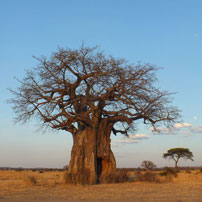 ‘Look across the river’ advised our guide as we arrived at Jongomeru Camp in the remote southern sector of the Ruaha National Park. Doing as instructed I gazed across the dry riverbed and there, taking shelter from the intense midday sun, was a small herd of elephants. Bags deposited in the beautiful and spacious tent, lunch was taken watching the herd, accompanied by the occasional trumpet or snort as they gently jockeyed for position in order to get the best bits of shade.
‘Look across the river’ advised our guide as we arrived at Jongomeru Camp in the remote southern sector of the Ruaha National Park. Doing as instructed I gazed across the dry riverbed and there, taking shelter from the intense midday sun, was a small herd of elephants. Bags deposited in the beautiful and spacious tent, lunch was taken watching the herd, accompanied by the occasional trumpet or snort as they gently jockeyed for position in order to get the best bits of shade.
A wonderful welcome to Ruaha National Park, Tanzania’s largest, and thus began the pattern for the next five days; encounters, some closer than others, with species big and small (some tiny!) in a landscape of towering ‘Tolkienesque’ baobab trees, winding river courses reduced to barren sand rivers at the end of this dry season, rocky outcrops, woodlands and open savannahs.
Combining the Selous Game Reserve (see Fran’s trip report) and Ruaha National Park in southern Tanzania is certainly the road less travelled. Access from Dar es Salaam is generally by light aircraft air transfers and the number of camps is small, making both destinations more exclusive than their counterparts in the north of the country.
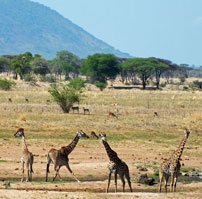 Ruaha stands on the cusp of two vegetational eco-systems; the miombo woodland of southern Africa and the acacia forests more characterised by the Maasai Steppe eco-system. This convergence leads to an exceptional variety of plant life, mammal species and birdlife.
Ruaha stands on the cusp of two vegetational eco-systems; the miombo woodland of southern Africa and the acacia forests more characterised by the Maasai Steppe eco-system. This convergence leads to an exceptional variety of plant life, mammal species and birdlife.
Defassa waterbuck, roan and sable antelope and the majestically handsome greater kudu, most commonly found in southern Africa live cheek by jowl with species more commonly found further north such as Grants gazelles and lesser kudu. Ruaha is in fact one of the few places where both species of kudu are found.
 Large buffalo herds roam the park and elephant numbers are as high as anywhere else. Bird species number well over 500 with migrants from both within and from beyond African shores. Then there are the predators; leopard skulk amongst the rocky kopjes, cheetah patrol the open plains and the healthy prides of lion can easily number in the twenties.
Large buffalo herds roam the park and elephant numbers are as high as anywhere else. Bird species number well over 500 with migrants from both within and from beyond African shores. Then there are the predators; leopard skulk amongst the rocky kopjes, cheetah patrol the open plains and the healthy prides of lion can easily number in the twenties.
This is big game viewing country at its best.
Jongomeru stands alone in the southern edge of the park and offers a true wilderness experience; no mobile phone coverage, no Wi-Fi, and no other vehicles to be seen – just the sounds of the bush. Game viewing in this part of the park can be a little more challenging due to the dense woodlands but nevertheless less we saw lion, bat eared fox, giraffe and a lot of elephant as a herd of over 100 moved through the area.
This is reputedly also one of the better areas in which to see the shy sable and roan antelope which prefer to reside in the miombo woodland.
The eastern sector of the park is overlooked by Mt. Kimilamatonge, the base of which is dotted with large boulders and secret caves, ideal territory for leopard, not to mention the hyrax, rock agama and the dainty klipspringer, who are able to climb the rocks at seemingly impossibly steep angles.
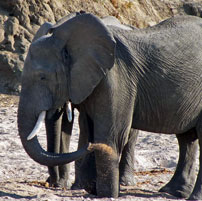 This is the ‘busier’ side of the park but with only four tented camps and one lodge, it never feels overcrowded and sightings, which centre along the river lines of the Great Ruaha and Mwagusi, are pleasantly quiet. Here, hippos and crocodiles share the ever decreasing pools of water, and elephants are often seen using their tusks to dig down into the sandy river bed in order to find fresh water.
This is the ‘busier’ side of the park but with only four tented camps and one lodge, it never feels overcrowded and sightings, which centre along the river lines of the Great Ruaha and Mwagusi, are pleasantly quiet. Here, hippos and crocodiles share the ever decreasing pools of water, and elephants are often seen using their tusks to dig down into the sandy river bed in order to find fresh water.
Each of the tented camps offers an authentic safari ambiance, but with its own individual style; down to earth and friendly Mdonya Old River Camp, where even the elephants may decide to join you for lunch; Kwihala, small and convivial, where the dinner conversation is likely to be punctuated by the raucous laughter of Festus, their resident guide; Kigelia Camp, the epitome of a bush camp, and characterful Mwagusi, where each banda has been designed and built around what nature provided – where else would you find a fossilised giraffe neck set into the bathroom wall?
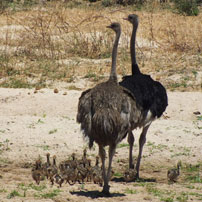 In spite of their differences, all the camps have one thing in common – fantastic game viewing on their doorstep. Scampering bat eared fox pups playing under the watchful eye of their parents, a leopard stalking a bushbuck, a pair of ostrich shepherding their young chicks, lazing lions, elephants silently making their way along the river line under a full moon, and perhaps most magically, watching a new born impala foal struggle to take its first steps.
In spite of their differences, all the camps have one thing in common – fantastic game viewing on their doorstep. Scampering bat eared fox pups playing under the watchful eye of their parents, a leopard stalking a bushbuck, a pair of ostrich shepherding their young chicks, lazing lions, elephants silently making their way along the river line under a full moon, and perhaps most magically, watching a new born impala foal struggle to take its first steps.
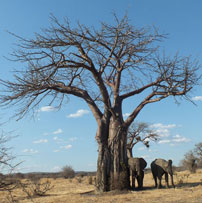 The dry season landscape in Ruaha is harsh and yet beautiful and provides a sense of remoteness that can be lacking elsewhere in Tanzania. This wilderness, matched with the superb ‘big game’ viewing in the park, makes Ruaha the perfect follow on to a few days in the Selous.
The dry season landscape in Ruaha is harsh and yet beautiful and provides a sense of remoteness that can be lacking elsewhere in Tanzania. This wilderness, matched with the superb ‘big game’ viewing in the park, makes Ruaha the perfect follow on to a few days in the Selous.
If you are looking for a safari which offers variety of activities, landscapes and assured big game viewing, the southern circuit combination of Selous and Ruaha has to be a serious contender!
